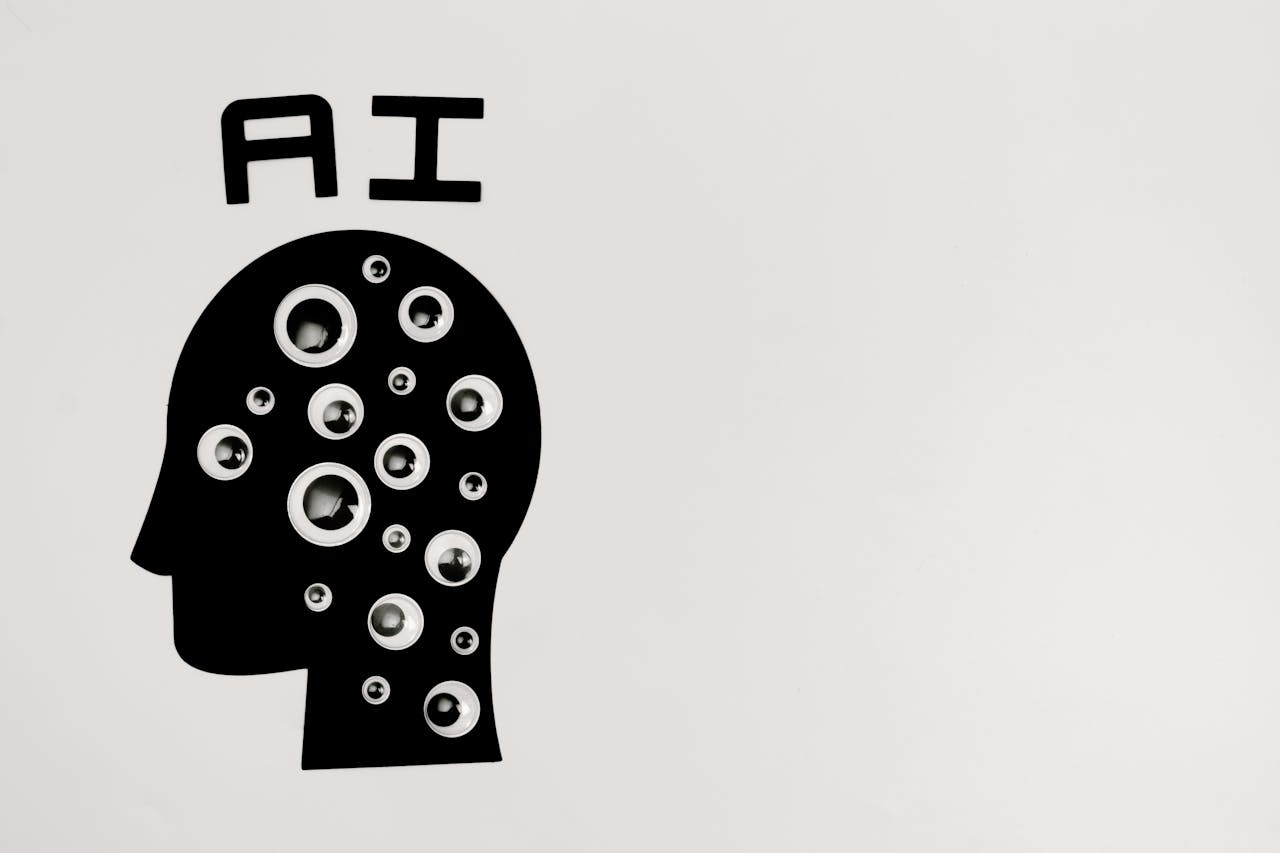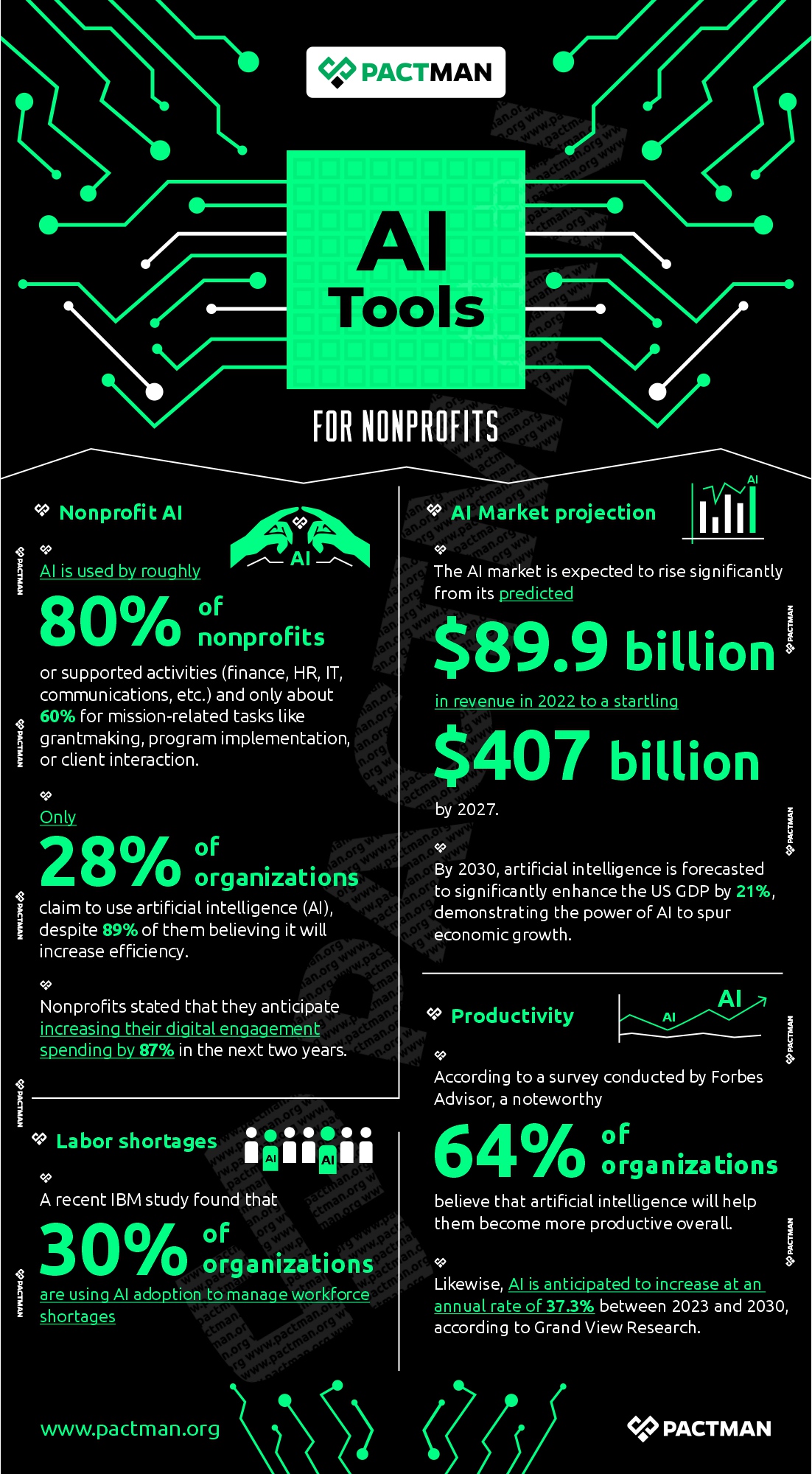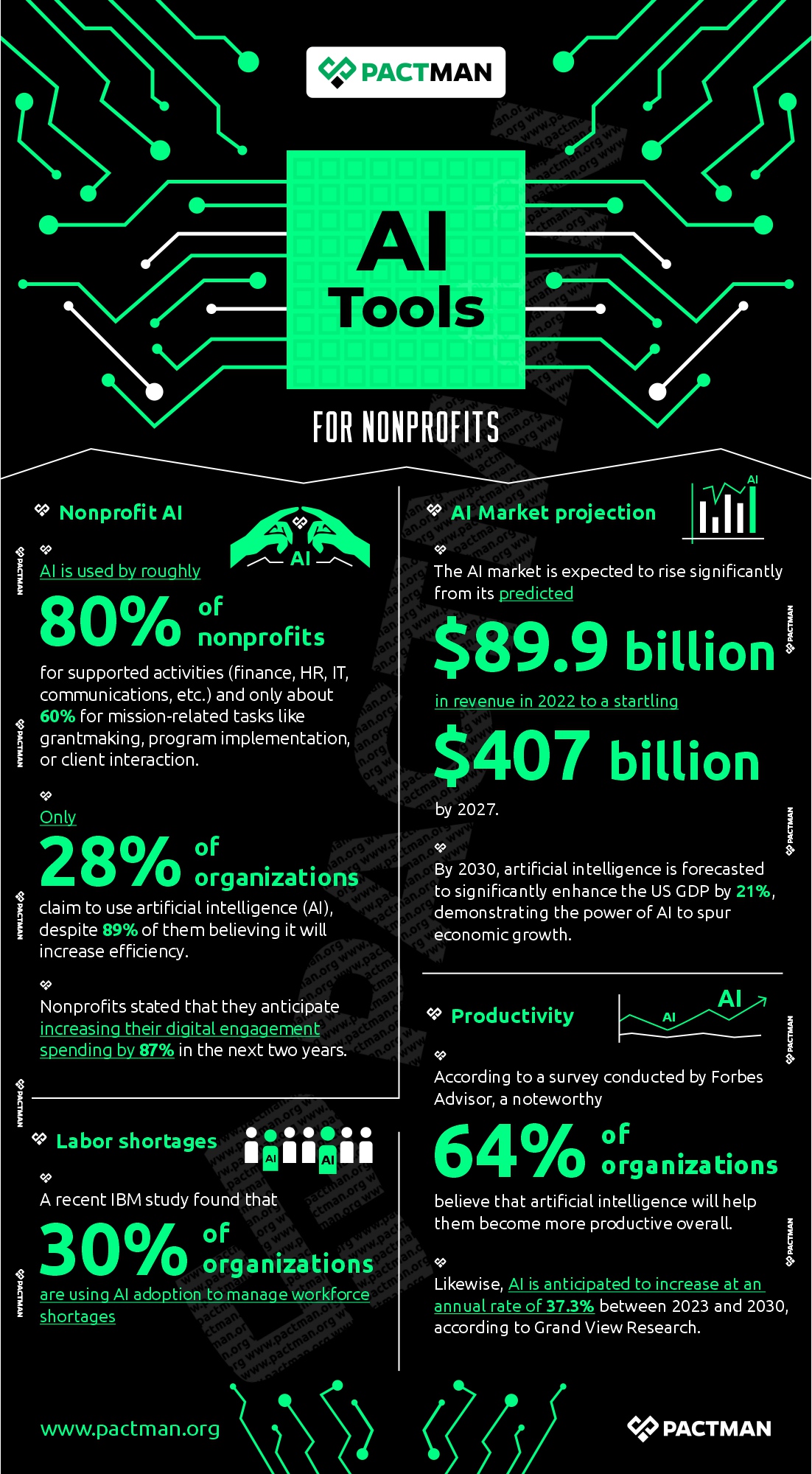I
Introduction
Artificial Intelligence (AI) is the driving force behind various disruptive innovations. Now more than ever, the ways that AI and AI tools affect people’s lives and careers will become more and more significant. This in turn will drastically alter the concepts of knowledge, capability, and strategy. Also, NGOs will be able to examine data, spot trends, and automate repetitive tasks to provide faster, more comprehensive client and donor service.

By adopting AI tools, nonprofits can improve their operations. Firstly, it ensures speedy efficiency. By automating repetitive operations, nonprofits can spare staff time, analyze massive amounts of data, and discover patterns and trends. Additionally, it assists nonprofits in making decisions based on statistics rather than intuition. This will make it possible for organizations to direct human attention toward tasks that are more people-appropriate. Among such include fostering closer bonds with donors and prioritizing problem-solving and longer-term improvement.
However, a relatively small percentage of organizations have the time, finances, or ability to make meaningful use of the data they gather by incorporating AI. This is despite the fact that more and more are discovering the enormous potential of using AI to inform their strategy. In this article, we will consider AI tools for nonprofits and how organizations can begin their journey in adopting AI across their various operations.
II
Understanding AI and AI Tools
AI integrates engineering and science to create intelligent machines. The broad topic of artificial intelligence deals with problem-solving with computers. By and large, AI is a broad field with many applications in development and humanitarian efforts. Hence, investing in sophisticated ways to adopt AI as an organization is often worthwhile. Generally, it requires four processes to function: the abundance of data; algorithms (mathematical models to analyze the data); tools (computers and software); and strategy questions (applying it to your organization’s work).

On the other hand, AI tools are software applications that can be used to automate and perform human tasks as well as solve problems with computers. Most importantly, before integrating new technology into a nonprofit’s operations, there is a need to address many obstacles. To begin with, organizations must be ready to think differently. Although there are clear and substantial advantages of AI, changing behaviour is infamously challenging. However, this shouldn’t be a source of discouragement. Rather, the difficulties should drive organisations to always seek out the most effective ways to complete tasks and, in the process, apply data to help modify organisational behaviour.
Generally speaking, it’s highly possible that some software or solutions that nonprofit organisations are adopting for fundraising already incorporate artificial intelligence. Nevertheless, the most significant potential for AI in fundraising is to enable organisations to manage more effective fundraising campaigns by improving their comprehension of donor relationships and supporter base.
III
Statistics on AI Tools for Nonprofits
In this section, we will consider how statistics prove the importance of AI tools and how organizations are adopting AI into their operations.
a. Nonprofit AI
AI is used by roughly 80% of nonprofits for supported activities (finance, HR, IT, communications, etc.) and only about 60% for mission-related tasks like grantmaking, program implementation, or client interaction. Also, only 28% of organizations claim to use artificial intelligence (AI), despite 89% of them believing it will increase efficiency. Nonprofits stated that they anticipate increasing their digital engagement spending by 87% in the next two years.
b. AI Market projection
The AI market is expected to rise significantly from its $86.9 billion in revenue in 2022 to $407 billion by 2027. By 2030, artificial intelligence is forecasted to significantly enhance the US GDP by 21%, demonstrating the power of AI to spur economic growth.

c. Productivity
According to a survey conducted by Forbes Advisor, a noteworthy 64% of organizations believe that artificial intelligence will help them become more productive overall. This shows how people’s belief in AI’s ability to revolutionize corporate operations is expanding. Likewise, AI is anticipated to increase at an annual rate of 37.3% between 2023 and 2030, according to Grand View Research.
d. Labor
A recent IBM study found that 30% of organizations are using AI adoption to manage workforce shortages. This proves that AI assists companies in streamlining processes and making up for a shortage of human capital.

e. Countries adopting AI
AI adoption is highest in China as 58% of organizations are using the technology, and 30% are considering integration. The United States has a lower adoption rate with 25% of US organizations utilizing AI and 43% investigating its possible uses.
f. AI Strategy
AI is ranked as a top business strategy priority by about 4 out of 5 firms. As a result, 47% of organizations have included AI in one or more operational processes. According to a report, there will be no human interaction in the management of 95% of organization and client connections by 2025.
IV
Examples of how nonprofits can leverage AI Tools
Organizations invest a significant amount of time and resources in answering questions and vetting new clients. Automating these procedures is possible with chatbots, which are online conversational interfaces. At its core, Artificial intelligence and natural language processing are used to create chatbots.

In 2016, Facebook launched Messenger to enable businesses and organizations to build their chatbots for use on the network for interactive experiences, content creation, e-commerce advice, and customer service. By 2018, the number of Facebook Messenger bots in operation exceeded 300,000. Additionally, there are now more bot creation tools accessible that let non-programmers construct bots. You have likely conversed via text with a chatbot without realizing it when you clicked on a business representative to make inquiries.
For the most part, Chatbots enable a charitable organisation to communicate with its supporters seven days a week, twenty-four hours a day at virtually no expense. Chatbots can respond to inquiries thereby enabling employees to work on other projects. As a result, nonprofits are using chatbots more and more frequently.
Here are some good examples of nonprofits that have leveraged AI for speedy efficiency.
1. Direct Relief
When the 1.5-person social media team at Direct Relief, a humanitarian aid group, was overwhelmed by requests for help following Hurricane Harvey in 2017, the agency turned to Facebook message bots. Inquiries concerning the organisation’s emergency response initiatives, aid applications, volunteer and donation opportunities, and other frequently requested issues were addressed by the bot. Not to mention, staff members could not have responded manually on time.
An intriguing observation regarding Direct Relief’s chatbot experience is that, while the majority of queries were addressed on the company’s website and Facebook page, the conversational style of chatbots facilitated information seekers in finding what they needed more quickly and entertainingly. Using the bot to efficiently engage at scale was one of the many benefits of adopting the AI tool.
2. Oxfam
Secondly, the silos of larger organizations can conceal valuable knowledge and insights. However, by developing and utilizing a proprietary toolkit of internal automation and bots, Oxfam addressed this obstacle.
As an illustration, employees found it challenging to exchange ideas and perspectives with colleagues at different Oxfam affiliates. Also, the only means of information sharing they had available to them was standard email. This demands searching through thousands of files on internal drives to discover fresh information. To generate a fresh knowledge base of concepts and insights, Oxfam leveraged bots to swiftly comb through the 10,000 staff members’ files and internal communications.
3. Mencap
Thirdly, the British organization Mencap allows people to interact with a young child with learning impairments using a chatbot called Aeren as part of its #HereIAm campaign. Following supporters’ interactions with the bot, Mencap observed a 3% increase in awareness of the needs of the disabled.
Without a doubt, collaboration-promoting bots can aid in igniting an internal philanthropic culture in which all members of the organization can foster and interact with employees, supporters, and donors.
V
Effective Ways Nonprofits Can Leverage AI Tools
In this section, we will consider how Nonprofits can adopt AI tools across their various operations to ensure efficiency.

a. For speedy response
For frontline staff at social service agencies, identifying and prioritizing the needs of potential clients can be a very time-consuming task. AI tools have the potential to optimize the intake process, minimize client wait times, and free up staff for other duties. Also, organizations can create their crisis text line which is always accessible.
By incorporating AI, organizations can shorten caller wait times and identify those who are in danger right away. This shows how nonprofits can successfully scale their service by using artificial intelligence, notably machine learning algorithms and natural language programming to carry out their operations effectively.
b. For Prospecting:
Also, algorithms for making predictions can be used to scan your database of donors or corporate sponsors. This can help identify the most likely prospects for gifts and the areas where your nonprofit should devote more effort to cultivation.
For example, a tool called First Draft integrates with Salesforce.org to provide Major Gift Officers with a weekly action plan. This includes recommendations for personally contacting donors, demonstrating the value of their gifts, and providing follow-up instructions.
c. To Improve Engagement:
AI can be used in a few different ways to increase online engagement. It can help with setting up and testing donation landing pages. In addition, nonprofits can leverage AI tools to create customized email messages, examine open-ended comments that donors leave on the organization’s call centre or website feedback forms, and identify important themes regarding what donors require to effectively shape engagement and communication.
d. For Repeat Giving:
Also, nonprofits can convert one-time donors into recurring donors by testing images and material for social media ads, email content, and information with the use of AI analytics tools. Charity Water, a nonprofit organization uses a tool, Quilt.AI, to help analyze Facebook ad material to boost conversation rates and subscription giving.
e. For efficient fundraising:
Reviewing CRM to determine who to schedule meetings with can be time-consuming. This is especially true in smaller fundraising organisations where the staff handles several donor programs, large gifts, and corporate sponsorship. One smartphone app that makes use of machine learning is NeonOne. The software tool assists small to mid-size nonprofits with managing volunteers, fundraising, events, and communications, among others.
f. For Data Analysis
Lastly, AI tools can also be helpful when it comes to data analysis and forecasting the behaviour of current donors. Essentially, machine learning can be used in fundraising to examine donor data and spot trends that will enable organizations to effectively target likely donors.
Machine learning models can sift through enormous datasets, such as your donor database, to precisely spot patterns and trends and forecast future results. This means that machine learning models can allow NGOs to identify the best donors for different fundraising campaigns. All in all, this is by taking into account the possibility that such individuals will make a gift if properly asked for or stewarded.
Over the years, nonprofits traditionally used segmentation to guide their fundraising efforts. This involves taking the database and using a few basic criteria to put donors in one category based on factors like frequency, recency, or monetary value. Depending on these segments, persons would either be left off of the audience list or included for future requests.
AI enables NGOs to handle donations as people rather than as a section. Additionally, it helps fundraisers have a deeper understanding of their donors and form extremely precise predictions about what each donor is likely to be interested in. This includes the kinds of campaigns or requests they are most likely to be open to.
By all means, Artificial Intelligence will be utilized to address some of the most pressing issues of our day, like global warming. Unlike before, AI and other cutting-edge technology now have lower entry barriers, making them more available for a wider range of missions. Now more than ever, new technologies like AI that enable organizations to raise more with less and effectively expand their impact must be well invested in to ensure impactful engagement.
VI
How Nonprofits can Begin their AI Journey
There are four (non-exclusive) ways to put new AI tools into use. Nonprofits can choose to adopt one or more options.

-
Work with an AI group
Presently, an increasing number of groups are providing NGOs and social entrepreneurs with free AI support. This help might come in different forms, from system development to counselling. A few of the most renowned companies that assist in this area include Google AI, Microsoft’s AI for Good, AI4good, Open AI, and Datakind, among others.
However, the fact that AI is a highly specialized topic presents challenges in addition to application success. As a result, NGO staff must possess at least a conceptual grasp of AI for the project to succeed and to protect beneficiaries and other stakeholders from danger.
-
Embrace Innovation & Collaboration
Effective integration of AI systems into an organization demands curiosity, transparency, and a strategy for iterating outcomes. Wise nonprofits will engage in ethical open-sourcing and share intellectual property (such as models and online and mobile applications) to maximize efforts. Additionally, to have a deeper comprehension of the end-user—whether it be employees or external stakeholders—there is a need to adopt design thinking methodologies.
Even more, a move away from compartmentalized methods of data collection and analysis will be required since the majority of organizations may have to join massive data collaboratives to benefit from AI.
-
Hire an AI team
Alternatively, you can choose to employ a person or group to create a solution specifically tailored to your project or nonprofit. Essentially, the two most crucial things to consider when hiring include having the appropriate field expertise and a history in development and humanitarian work. While hiring a team will cost more, it can still be worth it in the long run because you will have more autonomy than accepting pro-bono work.
-
Create an in-house team
Also, establishing a team within your organization can be a more sustainable approach. Though it is the most costly and time-consuming option, it could significantly alter the impact of your nonprofit’s work and its capacity to obtain new funds. Nevertheless, it will be extremely difficult to assemble a team with knowledge of AI and the third sector.
-
Use predesigned AI tools or create an original tool
Lastly, you can modify pre-designed tools to suit your needs. Even if it sometimes calls for obtaining a license and training, this is a soft start that can assist your organisation in determining whether an AI project is viable. Ultimately, you can engage businesses to create custom apps that satisfy your nonprofit needs.
Conclusion
To move forward, nonprofits must not only embrace AI but also comprehend its advantages and disadvantages. This includes how it will affect internal processes, program delivery, fundraising, and other aspects of their daily operations.
As can be seen, nonprofits must adopt a different strategy in the face of artificial intelligence, emphasizing innovation, experimentation, and adaptation. Previously, several NGOs with limited resources, including restricted funds for technology, were unable to afford AI tools. However, AI is now available to organisations of all sizes, enabling them to generate funds more intelligently and effectively. Also, taking a broader view, nonprofit organisations must acknowledge how their roles in society are changing and how contemporary technology can support their initiatives.



2 Responses